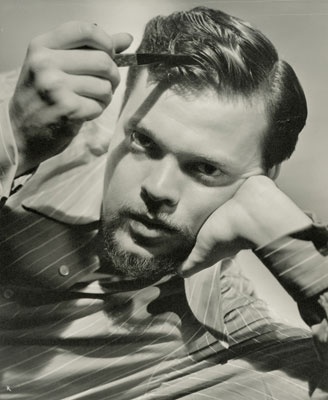Made in Hollywood: Photographs from the John Kobal Foundation
At the Santa Barbara Museum of Art. Shows through October 5.

Collecting shots of one’s favorite celebrities wasn’t always as easy as hopping on the Internet. Hollywood historian John Kobal knew this, having devoted his life to acquiring portraits of the stars of the late teens through the ’50s. Now showing at the Santa Barbara Museum of Art are more than 90 of Kobal’s vintage prints, each of which exudes the now-foreign glamour of early-20th-century Hollywood.
Made in Hollywood is the third chapter in SBMA’s series of exhibitions about Hollywood’s “Golden Age” and the most wide-ranging of the trilogy. Though few of us have actually seen Boris Karloff in The Mask of Fu Manchu, most of us know what we’re looking at when we see the stern Englishman in the distinctive mustache style that’s come to bear the name Fu Manchu. Equally few of us have sat through the original Tarzan films, but a shot of Johnny Weissmuller-loincloth, trapeze, and all- nonetheless sets off the “Don’t I know him?” buzzer.
But this show is not all criminal masterminds and jungle heroes. The leading men and ladies of the day occupy most of the wall space with their glamour dials cranked up to 11. There is an inscrutable Ingrid Bergman, an amused William Holden, an ethereal Hedy Lamarr, and an intense Gary Cooper. All are posed, dressed, lit, and made up with what, by today’s standards, looks like an obsessive precision. In promoting their stars, the studios left nothing to chance, an attention to detail that extended to the selection of the skilled craftsmen taking the pictures. Especially well represented are Clarence Sinclair Bull, perhaps best known for his surreal-looking shot of Alfred Hitchcock filming the MGM lion, and Ernest Bachrach, whose portrait of Orson Welles brings the worshiped auteur’s troubled, driven essence straight to the foreground.
Images of current movie stars tend to put them in everyday settings, in casual dress and tousled hair, although the location scouting, clothes selection, and hair tousling are likely to have been performed by well-paid consultants. One only really notices that strategy after spending time with images like these from Kobal’s archives. They’re just as laboriously crafted, but in what feels like a more honest, straightforward way. Each portrait acknowledges, in its otherworldly monochromatic beauty, that a great deal of work went into engineering its appeal. None are shy about admitting it.



